Middle harbour is a remarkable waterway in that despite being only a few kilometers from Sydney’s CBD there are still stretches in the upper reaches where you can sit quietly fishing without experiencing any signs of civilization. My next crew mate to comment that “you could be almost anywhere “ will not be the last.
The bordering Garigal National park keeps much of upper middle harbours towering valley foreshores free from urban development and lush in natural bush land , barely changed from what Governor Philip would have experienced on white fellas first expedition into this valley in April 1788. Black fellas were hanging around here well before then of course, as is evident from the numerous , deeply bedded middens on the foreshores , carbon blackened cave roofs and rock carvings found in the upper escarpments.
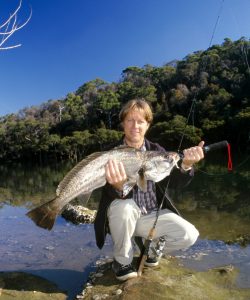
Water quality has improved dramatically in recent years and there are a number of factors influencing this. The banning of Tributyltin-based antifouling paints has resulted in a dramatic increase in intertidal shellfish. Tributyltin was so effective that not only would nothing would grow on the hull but even within ten meters of the boat. The combined effect of one big marina could poison everything within a kilometre . The combined effect of Middle Harbours half a dozen big marinas and hundreds of swing moorings virtually poisoned the whole system. Today the come-back has been startling with oysters growing on oysters and muscles on the spit bridge pylons that would do any paella proud
Siltation , a result of unregulated urban development , in the upper reaches was severe. One old timer told me that “you could almost walk from Roseville bridge to the headwaters on the river bed” . Stabilization of catchment development and an extensive dredging program between 1960 — 1981 returned it somewhere near its original state.
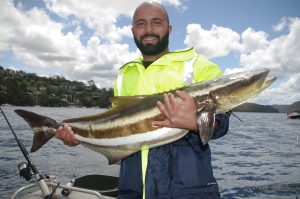
The only devastating act of environmental vandalism in the upper reaches that has never been rectified was the destruction of Sydney harbours largest sea grass bed by Warringah council. Acres of sea grass was backfilled to create what was then Roseville boat ramp and recreation area and is now , in a bizarre twist of irony , Garigal National park. Bulldoze sea grass to create a National Park ?.
Water quality in general has improved dramatically thanks to the clean waterways program introduced by the water board in 1989. This program , which included the offshore move of Sydney’s three major sewer outlets and numerous catchment management programs has made an incredible difference . More specifically the north side storm water storage tunnel completed in 2001 has been the icing on the cake for middle harbours water
Middle harbour differs from most other estuaries and rivers in that it is a flooded valley. Unlike the Hawkesbury , for example , whose path was cut by running water falling off a huge catchment area , the middle harbour valley simply filled up when sea levels rose at the end of the last ice age. In a way it is a lot like an impoundment in that it is very deep and the main features are the old creek bed and all the landform features that made up the original valley when it was dry. Because of the tiny catchment salinity levels are similar to that along the coast and at its deepest point it reaches 120ft . You need to go half a kilometer off sydney heads to find that depth. As a result Middle harbour offers a perfect environment for big fish and oceanic species that would otherwise find your classic river or estuary environment quite unsuitable.
Dolphins come in as do big sharks. A 3m bull shark was netted by fishermen at grotto point in 1999 in only two meters of water and I have no doubt that it was either on its way up or back out of middle harbour. Six fatalities have occurred in middle harbour , four well upstream near Sugarloaf bay and two in the shallows near Balmoral. This makes Middle harbour the shark fatality capital of Australia. If we could tap into local aboriginal history I’m sure we could add to this list as most of the local rock carvings above Bantry bay feature the unnerving combination of very large sharks and very small bark canoes.
Amongst the engravings are many deep bodied , forked tailed fish , probably bream and a similar proportioned straight tailed fish most likely luderick , indicating they that they were extensively hunted. Countless millennium of being stalked may go some way to explaining how the clear water , middle harbour bream has evolved into the cautious critter that it is today.
Strangely anything remotely representing mullet amongst the carvings are absent which is unusual given that middle harbour was once so densely abundant with them that the original colonial name for this waterway was Mullet River. They are easy targets with a spear too. Maybe the original inhabitants found them as unappetizing as we do.
The only obstacle to very regular visits from big oceanic fish is the shallows of Hunter bay at the mouth of middle harbour. The deepest Channel through here is , at best, only three meters but this hasn’t stopped big blue grouper , jewfish , kingfish , northern bluefin and yellowfin tuna , spotted mackerel and cobia from making the trip upstream in previous years.
Hump head snapper were regulars in past years and we still get bonito , salmon , frigates and spangled emperor regularly enough to make them worth targeting.
Sea turtles come up in summer and penguins occasionally follow the anchovies in . The lower flats abound with yabbies , the upper ones with cockles , squirt worms and black crabs ( although you can’t take them – it’s all IPA — that’s intertidal protected area- not Indian pale ale) and you can comfortably eat the blue swimmers from Balmoral or the Muddies from Sugarloaf. If you cut your foot on a barnacle while retrieving a snagged squid jig at balmoral you won’t need a penicillin shot as you would almost certainly have 20 years ago and you can stop at Sugarloaf bay for a quick dip on the way home without the burning eyes or ear infection.
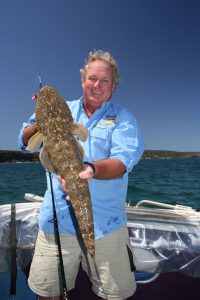
And the best news of all is that it is only going to get better.
I will start at middle head and work through the fishing options all the way to the headwaters.
The lower reaches around cobblers and balmoral beach are relatively shallow averaging only about 15ft almost right up to chainman’s beach. It gets a bit deeper down around cobblers and the naval base and the main channel runs up close against the south western shore of balmoral and wy-ar-gine rocks. Drifting anywhere through here will produce both sand and duskies flatties . Down towards cobblers there is a bit of reef on sand and a couple of old trucks dumped by the military . This is a good jew ground at night and will produce kings by day along with dory bream trevs and the bigger flatties. The southern calamari kelp beds in these lower reaches are found at Cobblers , the island at Balmoral , Wy-ar-gine rocks and across the bay at Grotto pt. From here upstream you will mainly find common squid. The naval base has been out of bounds since September 11 but in its day it was a truly magic fishery. There wasn’t much that wasn’t caught there including a 60lb Cobia and hordes of big surgeon fish . They are very serious about the restrictions now and if you venture in you risk losing your boat. There’s an amazing tale of an angler being dragged off the jetty by a huge fish in the 70ies , never to be seen again (see box) .
There’s some great flattie luring in amongst the moorings in the southern corner of balmoral.
Despite its shallowness this region can come alive with pelagic action when conditions are right. You won’t get a lot of big fish here but this can be compensated for with quantity. Ive seen the entire stretch from cobblers to the Clontarf drop off boil with a combination of Kings , Salmon , Tailor and bonito . This sort of action can usually be expected in November/December.
If you are looking for a tricky little bream spot try Jonnies corner which you will find on the outermost point of south eastern end of Wy-ar-gine rocks . Follow the kelp out till you hit the sand.
Moving up the river you hit the Clontarf Chainman’s drop-off. This remarkable bar goes from 15 ft to 70 ft over a run of only 50m . You will catch anything here . It’s a top night jew spot and by day you will get kings dory, big duskies, reddies , tailor and big whiting. Watch your sounder as you go from balmoral towards the spit and you cant miss it.
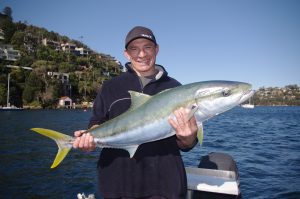
Now you are in the deep water and it stays that way until you get well up stream. There’s some good jewie fishing and some exceptional kingie fishing in this stretch running up to the bridge but its hard to fish. The NSW Maritime authority are pretty strict about anchoring in the channel here so you must keep inside the moorings . This is good and bad . The fish usually cruise the mooring line in search of squid which , by the way, are quite abundant through here but when you do hook a big fish it’s the last place you want to be. The best spot in this stretch is across the mouth of Fisher bay where a nice eddy concentrates bait . If you are after a bigger than average amberjack then this is the spot.
It shallows up as you move under the bridge . There’s some beauties in the shade but you cant stop anywhere here in a boat so its best fished from the shore. It drops back in pretty soon , before you reach the end of the 8 knot zone. On your left you will find d’albora marina which the owners have declared a ‘Marine sanctuary’ but the good news is that its not. You can’t get on it unless you are a member but that doesn’t stop you anchoring upstream on a run out tide and fishing back under it. By golly there’s some fish under there.
Further into the left are a pile of swing moorings that fish well for big Blue swimmers , squid , jackets and tailor.
Head upstream and keep left past beauty pt into long bay. Quakers hat pt and bay hold good kings and is a nice spot in a southerly. Long bay is generally good for dory in winter. Straight across from Quakers is an abrupt point called fig tree. This really breaks the flow and is great for bream , jew , kings and jackets. Jonnie , who knows all the tricky spots , pulls big blue grouper here. If you keep heading up stream you get to Tunks park boat ramp . Its not a bad two lane ramp with limited parking . It almost became unusable a few years back with silt but they gave it a good dredging when they built the storm water storage tunnel and it works and fishes well now. There’s a storm water outlet here and when its pumping in April/ May you will get good bream and jewfish here. Just before you get to Tunks park on the right there’s a little bay with a wreck in the shallows . This fishes well for bream and there’s some hideous tackle thief in there too, maybe a black cod — let him go if you catch him .
Back out into the main waterway now and heading upstream towards the Roseville bridge you will find Seaforth bluff on the right. This is one deep gnarly drop-in with a bit of rough stuff and a few lines of moorings for some shade. Its very good king ground and Captain Johnson tells me its also middle harbours best Jew ground by night. You will also get good bream here when they are running. If you head towards the middle of the river here you will find Middle harbours deepest water at about 120ft on the highest tide. It was rumoured that the third , never recovered Jap mini sub might be lying somewhere here deep in the silt as there was local reports of sightings of a periscope moving about here the day after the 1942 garden island attack. The sub was found recently off Collaroy
Keep going across into sailors bay . The upstream point fishes well for kings and the entrance fires up occasionally with surface action , mainly tailor. Up the back it gets a bit congested with moorings but you will find bream jackets , gar and dory. The stretch of shore line from Sailors to sugarloaf is a great spot for the plastic throwers to start looking for Bream.
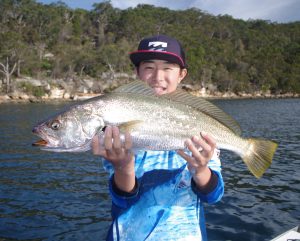
Jump back over to the other shore to Powder hulk bay where you will find VB reef. The story goes that the reef was created by a couple of old timers who used to take a case of VB twisties out on their weekly fishing trip and over a period of forty years built the reef by sinking the empties . Apparently the fishing was pretty ordinary for the first few years but as the reef got bigger and bigger the fishing got better and better. Maybe? — but there is a big lump there and it fishes well for kings , jew , Jackets , Reddies and tailor. You find it by lining up the starboard markers on seaforth bluff with the one on Pickering pt and driving directly between the two while watching your sounder. It comes up to about 65 ft from 80.
The upstream side of Pickering pt is a great king , jew and big flattie spot.
Straight across from Pickering finds you in Sugarloaf bay . Both the upstream and downstream points fish well for kings and jew . The upstream point is where Mick Collins got his legendary 25lb cobia in feb 2005. Just inside on the right is ‘The Steps’ , a great hole for boat fishing and shore based fishos best chance of a king or jew west of the spit bridge. Its also a good dory hole in winter. The bay splits in two and up the back of both these divisions are flats that fish well for flatties on the drop- off and bream on the flats at high tide . The right hand branch has extensive sea grass beds.
The stretch from seaforth bluff to the eight knot zone just downstream from Roseville ramp is the area where you are most likely to encounter pelagic surface action. Species include , kings , salmon , bonito , frigates and tailor. Prime spots are mouth of Bantry and sugarloaf bays and seaforth bluff across to sailors bay.
Moving further upstream on the right is Bantry bay. The southern point and southern shore , as far as the first little sandy bay , holds Kings. The south-eastern shoreline offers great bream luring and the drop-off on the flat up the end is your best big flattie on lure ground with good bream bait fishing over the flat on the high. To give you a clear example of how unique and diverse Middle harbour actually is , a few years back anglers were battling northern bluefin tuna only one hundred meters from the Bantry mangrove flats that they had been catching bream and whiting on only an hour earlier .The deep water in the middle is good dory and squid ground . Bantry is also your best shot at a mid winter king. Winter kings are an interesting critter , with enough fat for observant punters to pick the distinctly different cuts – especially the prized belly flap. We need to start paying more attention to the Jap chefs if we want to get the best from our ‘secondary’ seafood .
Both Bantry and sugarloaf will produce swimmers and muddies but the best muddies are above the Roseville bridge.
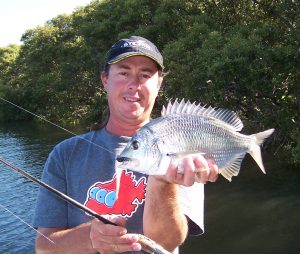
From Bantry to Killarney pt there’s not a lot of feature. About half way along there’s a slight point , marked with a channel marker , that fishes well for jew kings and tailor. The whole southern shore from Yeoland pt to Killarney point is very good bream luring.
Killarney point , the start of the 8 knot zone , is very prominent and the eddy it creates has scoured our a big jew hole on the upstream side. You will get pelagics right up to this point but they stop here fairly abruptly and only in the longest drought will they venture any further up stream. The exception to this is of course tailor who don’t mind a bit of fresh and the occasional big trev that nails a bream bait in the mangroves. Killarney point is a very good estuary luderick spot.
Moving upstream you hit the 4 knt zone just before the Roseville boat ramp. There’s some wild bottom here as a result of earlier dredging and cable laying. There’s a marked mid stream sand bank to your right which produces good flattie spinning . Further behind the bank in amongst the moorings produces good bream spinning and some monster whiting. Straight across the river is Roseville marina . They do an awesome espresso here and it is becoming a bit of a meeting break amongst the local jig flickers and fly boys. Some mornings it looks like a Columbia shirt convention. The marina is next to echo beach , a great shore-based spot for luring or bait fishing . Just before the beach takes a bend round to the marina you will see a little patch of broken rock , this is a top big whiting spot and you will probably nail one on lure if you persevere.
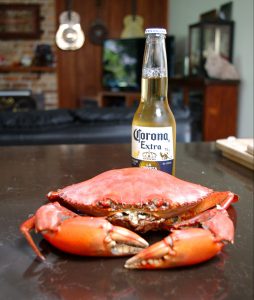
The Roseville bridge pylons produce hordes of big fan belly jackets and good jew , bream and flatties from the shore.
The mangroves and estuary start here and the very first big stand you see on the left is middle harbours number one big bream spot. Anchor offshore and flick lures or black crabs into the shallows on high tide. Its all good bream Flattie and jew luring from here up.
Its shallow for about the next km especially when you get up towards the fenced swimming area near Moores crk . Watch your prop on very low tides.
Moores crk comes in on the left and has a big sand bank at its mouth that produces bream and flatties. Watch your sounder now as the next hole you drop into is a good Jew luring spot . We have had all our success from the shore here despite working it extensively from the boat. Its only 23ft at its deepest point and maybe the boat spooks them. The Carol ck track follows the river closely hear so you can access the river at most points.
—————————————————
Back in the 50s the navy jetty off balmoral earnt it self a formidable reputation for enormous ,tackle breaking fish living amongst its pylons. Everybody assumed that they were kingies as big kings were occasionally spotted cruising around and taking big live baits. But despite attempts by naval personnel with all manner of obscenely heavy tackle including venetian blind cord on a trailer winch and ski rope tied to a army fork lift nothing was ever positively identified. In 1968 the navy jetty was opened to the public but even experienced anglers with more modern game tackle were unable to land these mystery fish. In the mid seventies a guy by the name of Chris Ward turned up with the latest in stand up game tackle. This included a gimbal bucket and all manner of clips and harnesses. The reel was loaded with venetian blind cord and the drag cranked up to the max. It wasn’t long before Chris’s big bait was eaten but he immediately realized he had made a big mistake. The drag on the reel would not give and as he was heavily strapped to the rod he was unable to let go. To the horror of the on lookers Chris was dragged across wooden planks and into the water. The body was never recovered and after a court hearing the jetty was again closed to the public on liability grounds.
In 1977 the mystery was finally solved when a prawn trawler working off Gladesville entangled a 376lb black cod( now fully protected) in its net. The cod was lying on the deck and one of the trawler men noticed heavy cord coming from the fishes mouth and leading into the water. The cord was retrieved to revealed a hideous discovery.
A rod , reel and gimbal harness containing the skeletal remains of a human torso rose up out of the water. The head arms and legs were missing so police were unable to ID the remains but decorative binding on the lower section of the custom built rod butt spelt out the word ‘Mango’.
Chris ward originally came from the Queensland town of Bowen where he had grown up on his fathers Mango farm. A quick check with his old school mates revealed that ‘mango’ had indeed been his nick name.
By Craig McGill